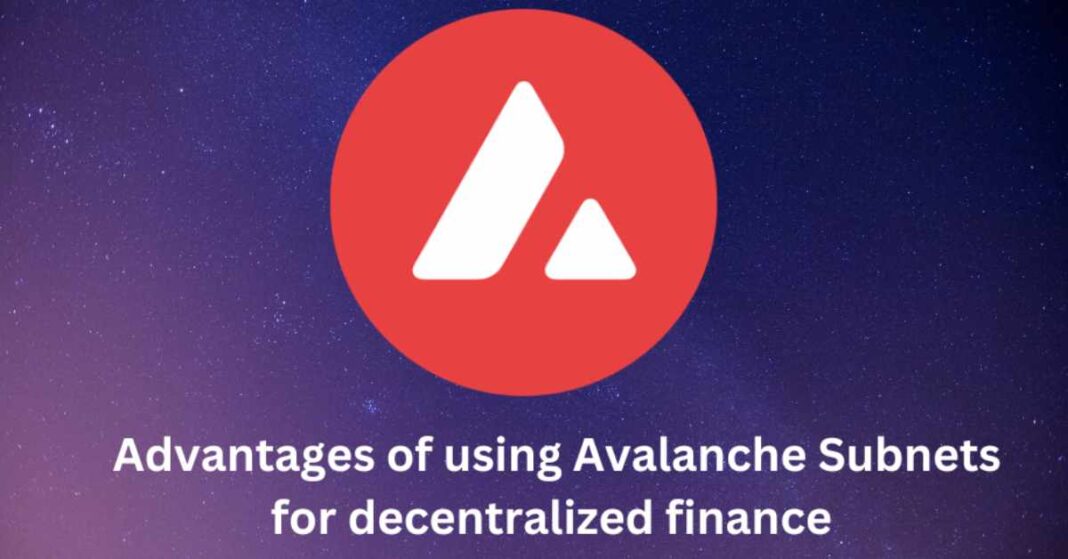Looking for a scaling blockchain solution that provides high-performance, security, and cost-efficiency, and is especially designed for decentralized finance (DeFi) applications? Look no farther than Avalanche subnets – the open-source scaling solution that allows users to build their own layer 1 scalable finance applications on this blockchain. Avalanche network includes the 3 types of blockchains: the X-Chain, C-Chain, and P-Chain, with each possessing defined role and functionalities. The unique set of features, robust governance, highly secure architecture, unique consensus mechanism and other such benefits make it a great choice for DeFi applications. In this article, we would delve deeper to understand the critical role of Avalanche subnets for building amazing Defi applications and as to what makes this a go-to platform for users for DeFi app developments.
Avalanche: Powering the DeFi Space
Avalanche stands out as a clear choice when it comes to building innovative and powerful DeFi apps that are scalable, great for user experience and can handle the huge volume of financial transactions, while also being cost-efficient and highly resilient against vector-attacks. Infact, a large number of DeFi applications are already built on this platform for network performance and speed, customization features, lower entry barriers, higher accessibility to users and a myriad range of other important benefits.
Avalanche subnets are powered by a consensus algorithm called Avalanche Consensus, which is designed to provide high performance and scalability while maintaining decentralisation. The Avalanche network also supports smart contracts, allowing developers to build complex financial applications. When it comes to handling global transactions securely and smartly, Avalanche is the world’s number one decentralized smart contract platform.
Also Read: What is a Cryptocurrency
Most of the action takes place on the Avalanche C-Chain, but the P-Chain is responsible for all things, including creating new blockchains and subnets. On the other hand, to exchange digital assets, you can utilize X-Chain. Finally, Avalanche is easy to integrate with other DeFi protocols, making it a great choice for developers looking to build and deploy DeFi applications quickly and easily.
Advantages of using Avalanche Subnets for decentralized finance
Increased Security
Avalanche subnets provide an extra layer of security for decentralized finance (DeFi) applications. By running multiple nodes in a network, it is more difficult for malicious actors to gain control of the network and manipulate data or transactions. This added security makes DeFi applications more resilient to attacks and helps protect users’ funds.
Unlimited Number of Validators
As you know, you can use an unlimited number of validators to secure your financial system. But sometimes it can slow down or be strenuous to maintain the system. So it’s essential to maintain a balance between security and performance when deciding on the number of validators.
Improved Scalability
Avalanche subnets can scale up quickly to meet the demand of a growing user base. This allows DeFi applications to expand their user base without sacrificing performance or security.
The Transaction Fee is Lower
Dcentralized in Avalanche subnets means the involvement of third party is zero. You need not worry about transaction fees because the transaction fee is too low as compared to other financial networks.
Faster Transaction Times
Avalanche subnets can process transactions much faster than traditional networks. It smooths the user experience by providing ultra-high-speed transactions with more security.
The Avalanche Subnet has no limits on how many transactions you can make per second or how much money can be exchanged on the network (just like other types of subnets). This means that your decentralized finance system will always be able to operate as fast as possible and handle any type of request from your clients quickly and efficiently!
Top DeFi Apps On Avalanche
GMX
The GMX is a decentralized exchange (DEX) and continual trading platform that validate users to trade their assets, including Ethereum, Bitcoin, and other popular cryptocurrencies. User leverage on their trades can reach 30%, which is impressive.
Benqi
Are you optimistic about the future of Benqi? Don’t worry, the future of Benqi is bright. Benqi allows users to invest, trade, and earn interests on their digital assets. With the Avalanche network, you can enjoy a scalable platform at low fees.
Aave
With the open-source Aave platform, users can sell and buy their crypto assets to earn income. If we talk about investment then you have a great opportunity due to its robust features and unique abilities. Aave also offers lower platform fees for investors.
Bungee
To offer the best product, Bungee combines all bridges, DEX and DEX’S aggregators. Bungee DeFi apps are decentralized finance (DeFi) applications that are designed to be used on the Bungee protocol. These apps are designed to provide users with secure and trustless access to financial services, such as lending, borrowing, and trading.
PoolTogether
Who doesn’t want to save their money? PoolTogether is a no-loss savings protocol that allows users to save money while also having the chance to win prizes. The user’s deposits are held in a smart contract and the prizes are given everyday. The interesting part is that you can keep all of your winnings if you lose.
The Future of Avalanche Subnets
According to CryptoSlate, the number of daily transactions increased and the subnet was improved significantly in 2022.
To meet the user’s needs, Avalanche Subnets allows anyone to create a customized blockchain bridge. The future of Avalanche subnets is most likely to involve a combination of existing technology and new innovations. For example, Avalanche subnets could be used to create decentralized financial services, create resilient peer-to-peer networks, and enable faster and more secure payments.
You can use Avalanche subnets to create decentralized financial applications, create and deploy blockchain networks, and to provide faster transactions experience.
With these applications in mind, it is likely that Avalanche subnets will become an important part of the blockchain ecosystem in the near future.
How you can deploy Avalanche Subnets
The goal of Avalanche subnets is to encourage everyone to build custom blockchain networks that align with their DeFi project’s needs.
You can use Avalanche to create and develop decentralised finance Dapps, trading apps, financial networks, and blockchain bridges. With the help of Subnets, it’s easy for you to customise blockchain networks for Web3 games. There is no need to compromise security or decentralisation. For deployment and development of DeFi apps, use managed blockchain services or a web3 infrastructure management platform. It can help deploy the Avalanche nodes in minutes, saving you time and money, also maximising efficiency and scalability. The node provider also allows you to swiftly manage and maintain nodes without getting into deployment hassles. It results in you having more time to focus on creating your product enhancing growth instead of spending time on maintenance.
Conclusion
The Avalanche subnet is the future of networking with its advanced capabilities, high speed and performance, and low latency.
Avalanche Subnet is a promising technology for decentralised finance. By reducing costs and increasing scalability, they can increase transaction security. The power of blockchain technology provides an efficient way to manage financial transactions in a safe environment.
Also Read: 5 Trends in Cloud Innovation














